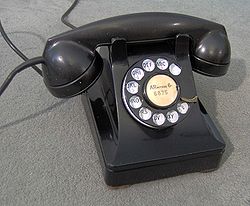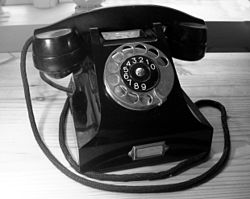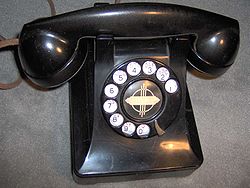- Model 302 telephone
-
The Model 302 telephone subscriber set was manufactured by Western Electric from 1937; manufacture of entirely new units was ceased after the introduction of the Model 500, but Model 302 units were continually remanufactured as such at least until 1958, and as the Model 5302 telephone which was simply a change to a more modern housing, well into the next decade. Overseas, the Model 302's exterior design was retained by European Bell branch companies for such models as the 1954 Bell Standard, widely used in the Netherlands and Belgium.
The Model 302 was in-plant from 1937 and was never completely retired from service. Designed by Henry Dreyfuss, it was the first widely-used american subscriber set to include the ringer and anti-sidetone circuitry in the same unit as the rest of the subscriber set; prior Western Electric models required the use of an external “subset” (ringer box). It was heavily influenced by Ericsson model DBH 1001 of 1931, designed in 1929 by the Norwegian artist and designer Jean Heiberg.
The Model 302's base shell was originally made out of cast zinc alloy and these zinc shells continued to be manufactured into 1946; but in 1941 manufacture of thermoplastic shells was begun. Thermoplastic shells were made into 1954 (with later manufacture of shells being for the purpose of remanufacture of sets). The first units used the E1 handset, had a vent under the cradle, and had feet riveted to their bases. Beginning in 1938 the F1 handset was used, the vent was eliminated, the feet were bolted to the bases, and the cradle flanges and switch-hook buttons were enlarged.
Most of the Model 302 sets came in black, but eight other colors — ivory, bronze, silver, gold, rose, blue, green and red — were added toward the end of the phone's production run. The early phones had metal finger wheels, while later specimens featured clear plastic finger wheels. Dial plates were made with white porcelain on U.S. WE 302 models, while European versions tended to use black bakelite with white numbers. The original handset cord was straight and covered with brown woven fabric, but a straight rubber-covered cord was later introduced, followed by a coiled rubber-covered cord.
The WE 302 was a rugged and easily repaired desk telephone. As part of its U.S. monopoly, most telephones were owned by AT&T, who leased them to subscribers for a monthly charge, some were sold, and can be identified by the handset which is coded F1W, the 'W' signifying without Bell System markings. Beginning in August 1955 and extending into the 1960s, AT&T began remanufacturing the Model 302 as the Model 5302, with a base shell of new design (and sometimes with a handset of new design) which gave the set something of the appearance of a Model 500.
In addition to the model 302, the Western Electric 300-series included many variations and special purpose models with additional features. Some can be viewed by following the external link below.
Other manufacturers produced sets of very similar appearance. Among the more notable of these were the Stromberg-Carlson Model 1243 telephone, distinguished by beveled corners and flanging on the handset, and the Federal Telephone & Radio model 803 (pictured) which featured components made by Automatic Electric.
Trivia
The WE 302 appeared in many films from the time of its introduction through the 1960s, and was ubiquitous in television shows of its time, such as the popular 1950s situation comedy I Love Lucy. Thus, it is sometimes called the “Lucy phone” by modern collectors on sites such as eBay as a quick way to refer to the model.
External links
Western Electric Standard telephones Special telephones Exchange switches Other technology Related companies Bell System · Bell Labs · AT&T Technologies · Graybar · Lucent Technologies · American Telephone & Telegraph · IBTC · Nippon Electric · Northern Electric · GTE · Stromberg Carlson · ITT · Automatic Electric · KelloggSee also Categories:- Telephony equipment
- Western Electric telephones
Wikimedia Foundation. 2010.



